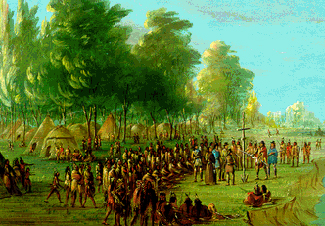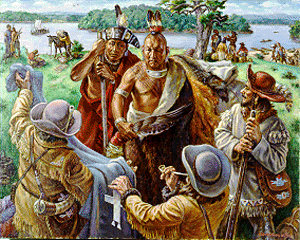Indians and Colonists
by George Sabo III

|
|
"Father Marquette and His Pipe of Peace" by A. Bobbet. Courtesy of University of Central Arkansas Archives.
|
After Soto’s survivors retreated to Mexico in 1543, no Europeans entered the central Mississippi Valley for more than a century. The 1673 voyage of Marquette and Jolliet to Quapaw villages at the confluence of the Arkansas and Mississippi rivers set the stage for the next series of encounters between Indians and Europeans. From the late seventeenth century to the early eighteenth century, several groups of French explorers made their way down the Mississippi from the Great Lakes and up the Mississippi from the Gulf Coast. At the same time, a handful of English traders reached the Mississippi Valley via overland routes from the Carolinas. These explorers entered an Indian cultural landscape quite different from that described by Soto’s chroniclers. Small and medium-sized villages surrounded by crop fields were occupied by Osages, Quapaws, Chickasaws, Taensas, Tunicas, and other Mississippi Valley groups. Only the Natchez along the lower Mississippi River maintained the old chiefdom landscape of agricultural villages connected to ceremonial centers with large platform mounds supporting temples, shrines, and chiefly residences.
The Indians of the central Mississippi Valley also used a new ritual—the calumet dance—to greet European visitors. In this ritual, the Indian community gathered at its ceremonial ground where visitors (Europeans or Indians from another tribe) were seated in a place of honor. Community leaders then brought out the calumet, which consisted of a carved stone pipe attached to a long wooden stem adorned with furs, feathers, paints, or other decorations symbolizing the community’s primary social divisions. The pipe was filled with tobacco and lit. An Indian leader generally presented the pipe to the four cardinal directions, the sky, and the earth. Then it was passed among the Indian leaders and their guests, each of whom took a puff before passing it along. Among the Osages and Quapaws, all assembled villagers and guests participated in the ceremony. Among the Caddos, only community leaders and the leaders of the visiting group smoked the pipe. A feast usually followed, often with dancing and other ceremonial performances. At some point during the proceedings, hosts and visitors exchanged gifts.

|
|
Detail from "LaSalle's Party Feasted in the Village of the Illinois, January 2, 1680" by George Catlin. ©1997 Board of Trustees, National Gallery of Art, Washington (Paul Mellon Collection).
|
Most Europeans viewed the calumet dance as little more than the formal recognition of a temporary truce, and a pretext for Indians to extract material rewards in exchange for their hospitality. Many Europeans only grudgingly participated in the gift exchanges. The Indians had a much more expansive purpose in performing this ritual. From their perspective, the calumet dance opened a social relationship with their visitors, bringing them into the network of rights and obligations shared by kinsmen. Some versions of the ritual actually conferred on a visiting dignitary the vacated social position of a recently deceased community leader. The ceremony thus created a bond of kinship, made sacred by offering the smoke to Above World deities. Through this bond Europeans and Indians could interact as kin; that is, as individuals sharing mutual rights and obligations of support. Indians viewed these ties as necessary for further political alliances or trade. In the Indian world, political and economic interactions within or between communities were organized by cultural principles borrowed from the realm of kinship. Europeans who did not understand this were seen as rather “stingy relatives.”

|
|
"LaSalle's Party Feasted in the Village of the Illinois, January 2, 1680" by George Catlin. ©1997 Board of Trustees, National Gallery of Art, Washington (Paul Mellon Collection).
|
A key event in the history of relations between French colonists and the Indians of the central Mississippi Valley took place in 1682, when Rene Robert Cavelier, Sieur de La Salle, claimed the region for France and named it Louisiana after King Louis XIV. La Salle actually performed two ceremonies proclaiming French possession of the territory, one at the Quapaw village of Kappa and the other where the Mississippi enters the Gulf Coast. The ceremony performed in the Quapaw village began with preparation of a memorial column to which the French attached a royal coat of arms. French priests offered prayers and chanted praises to God and King. La Salle read a proclamation asserting France’s claim to possession of the land. The French soldiers shouted “vive le roy” (“long live the king”) and discharged their firearms. The Frenchmen then buried a memorial lead plate at the foot of the column and officers signed the proclamation document. For their part, the Quapaws performed a particularly elaborate version of their calumet dance.
French colonization of the Louisiana Territory proceeded slowly. By 1720, only four towns existed: New Orleans and Pointe Coupee situated along the lower Mississippi River and Biloxi and Mobile located a bit farther east along the Gulf Coast. These towns were supported by a series of interior trading posts: Fort Toulouse up the Mobile River; Fort Rosalie, Fort St. Pierre, and Arkansas Post farther up the Mississippi; and Natchitoches and Los Adaes in the Red River region. Mississippi Valley Indians played a vital role in the colonial economy, supplying meat, hides, oil and tallow, and agricultural produce in exchange for trade goods. Indian commodities fed the colonists and provided goods (hides and tallow, in particular) they could sell elsewhere in North America or in Europe.

|
Osage Traders by Charles Banks Wilson.
Courtesy of the Artist.
|
Historian Daniel Usner reconstructed the trade system operating between Indians and colonists, which he called the “frontier exchange economy.” This system involved direct, face-to-face transactions between Indians and traders or merchants. Goods were not sold for money but were bartered using an agreed-upon schedule of values. For example, one flintlock rifle might be worth sixteen deerskins or five buffalo hides, and four more deer hides might purchase enough powder and shot to see an Indian through several months of hunting. Participation in the frontier economy drew Indians and Europeans together in a relationship of mutual dependence. Europeans relied upon Indians for food and commodities they could sell. As Indians grew ever more dependent upon trade goods, they had to adjust their activities and settlement locations to supply the goods required by Europeans. Indian men spent much more time hunting, and women spent more time preparing hides and other products for the trade.
The French colonization of Louisiana was tenuous in another way. There never were enough colonists or military personnel to provide adequate defense against English colonists in the Carolinas or Spanish colonists in Florida, should either of those rival nations choose to expand westward. Consequently, the colonial Louisiana government in New Orleans worked hard to maintain alliances with Mississippi Valley Indians for assistance in defending its borders. The Quapaws, for example, joined colonial French forces against the English-allied Chickasaws in 1736 and again in 1739-40, when English adventurers attempted to take control of the Mississippi River.

|
|
Henri de Tonti's Post on the Arkansas. Courtesy of the Arkansas Historical Commission.
|
These economic and military ties drew Indians and Europeans together, particularly during the early colonial period when the French struggled to gain their foothold in the Mississippi Valley. Many French traders began to spend more and more time in Indian settlements and decided to live in those communities. Some even married Indian wives. Indians and their French allies also began to relocate nearer each other to facilitate economic, military, and social interaction. Arkansas historian Morris S. Arnold has shown how Arkansas Post and Quapaw Indian settlements maintained remained in very close proximity, jointly relocating from time to time in response to flooding, and to the intrigues of the English-backed Chickasaws. Recently, archeological investigations by John House have identified the early locations of Arkansas Post and nearby Quapaw villages.
As the early Colonial era evolved, Indian and European communities developed what historian Richard White refers to as a “middle ground” relationship. In these arrangements, the two became closely intertwined, creating amongst themselves a novel series of economic, social, and political institutions drawing simultaneously on Indian and European traditions. Where middle ground institutions developed, both European and Indian nationalism faded into the background. Middle ground regions contained no separate Indian nations and European empires; there were instead networks of small, mutually dependent communities whose residents might include both Indians and Europeans whose day-to-day lives were shaped by local circumstances. Such was the case in the central Mississippi Valley throughout much of the colonial era.
Further Reading:
Arnold, Morris S.
2000 The Rumble of a Distant Drum: The Quapaws and Old World Newcomers, 1673-1804. Fayetteville, University of Arkansas Press.
Sabo III, George
1995 Rituals of Encounter: Interpreting Native American Views of European Explorers. In Cultural Encounters in Early America: Native Americans and Europeans in Arkansas, edited by Jeannie M. Whayne, pp. 76-87. Fayetteville, University of Arkansas Press.
2000 The Quapaw Indians of Arkansas, 1673-1803. In Indians of the Greater Southeast: Historical Archaeology and Ethnohistory, edited by Bonnie G. McEwan, pp. 178-203. Gainesville, University Press of Florida.
2001 Paths of Our Children: Historic Indians of Arkansas. Fayetteville, Arkansas Archeological Survey Popular Series No. 3.
2007 Native Americans. The Encyclopedia of Arkansas History and Culture. Encyclopidia of Arkansas Link
Usner, Daniel H., Jr.
1992 Indians, Settlers, and Slaves in a Frontier Exchange Economy: The Lower Mississippi Valley before 1783. Chapel Hill, University of North Carolina Press.
White, Richard
1991 The Middle Ground: Indians, Empires, and Republics in the Great Lakes Region, 1650-1815. Cambridge, Cambridge University Press.
|






